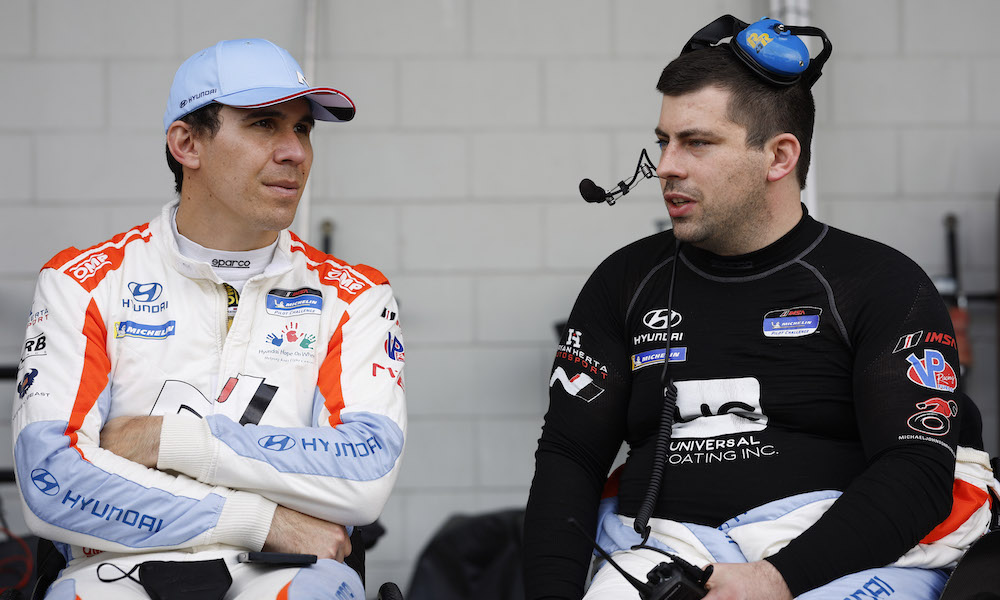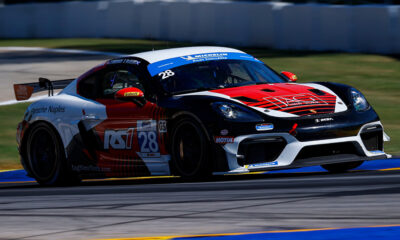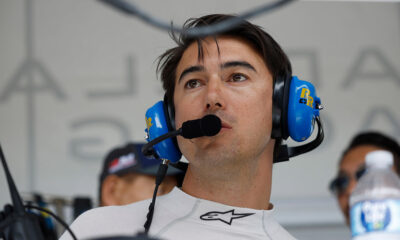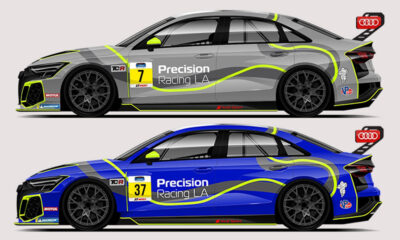It started as a simple concept, but its implementation wasn’t simple. It was complicated, is constantly evolving, and – credit where it’s due – simply ingenious.
When it became clear that Michael Johnson and Robert Wickens would both be driving a Hyundai Elantra N TCR in the IMSA Michelin Pilot Challenge for the 2022 season, engineers at Bryan Herta Autosport with Curb-Agajanian had to devise a hand control system that would fit the car, the drivers and the specifications.
What they developed – and continue to fine-tune – is winning races and turning heads.
“It’s the best system I’ve used to date,” said Johnson, who has been racing with hand controls since 2007.
Johnson and Wickens are paralyzed from the waist down. Their co-drivers, Stephen Simpson and Mark Wilkins, share Elantras equipped with standard brake and throttle foot controls that convert to hand controls on the steering wheel when Johnson and Wickens drive.
“The concept is simple – you’re using your hands instead of your feet – but that’s where the simplicity stops,” said David Brown, BHA’s technical director, who devised the system with BHA development technician Jonathan Gormley.
“It still has to be driven by somebody using their feet as well. You have the underlying brake, throttle and clutch systems all on the floor in the car, but then you have a duplicate set of controls for someone who can’t use their feet.”
The solution is a ring on the steering wheel that drivers pull toward themselves to brake, along with paddles to control the throttle. When Simpson and Wilkins are in the car, the brake and throttle hand controls revert back to foot controls.
Wickens, who returned to racing this year after a crash in an IndyCar Series race at Pocono Raceway in 2018, won at Watkins Glen International and Canadian Tire Motorsport Park with the system and stands third in driver points in the series’ Touring Car (TCR) class in the No. 33 BHA Elantra he co-drives with Wilkins.
Johnson, who was injured in an accident during a motorcycle race when he was 12 years old, has been using similar systems since he returned to racing in 2007 in a go-kart with hand controls developed by Alex Zanardi, who lost both legs in a 2001 IndyCar crash.
Johnson had been using a similar system in a BHA Hyundai Veloster N TCR he drove in 2021, but the Elantra hand control system is slightly different, mostly by way of throttle paddles and the feel of the brake ring.
The system’s superiority shows in the results. Johnson and Simpson are fifth in TCR driver standings following runner-up finishes at Lime Rock Park and Road America in the No. 54 Michael Johnson Racing with BHA Elantra.
“The way I get feedback from it is a lot better, especially with the improved brake ring and the throttle paddles we have instead of the big ring I had on the front of the steering wheel in previous years,” Johnson said.
“I like this system way better. I don’t want to say it’s easier, but it’s a much better user experience.”
As they prepare for the Virginia Is for Racing Lovers Grand Prix on Aug. 27 at VIRginia International Raceway, Johnson and Wickens are working with Brown and Gormley to find the sweet spot on the brakes.
“At some tracks we don’t need a ton of brake pressure, but other tracks we do,” Johnson said.
“That’s something we’re always trying to play around with. There’s so much adjustability that you can sometimes get lost. That comes down to the feedback I get when I’m on track.
“That part can always be improved, so that’s what we’ve been working on. That’s always something that will be a work in progress.”
Brown agrees. The device isn’t complete. Rather, it’s constantly being upgraded and tweaked, a never-ending experiment in racing with hand controls.
“We sort of came up with it as we went along,” Brown said.
“We tackled the problems and came up with solutions, experimented with it a bit and asked whether we liked it and what we could improve.”
It is, in a word, groundbreaking.
























